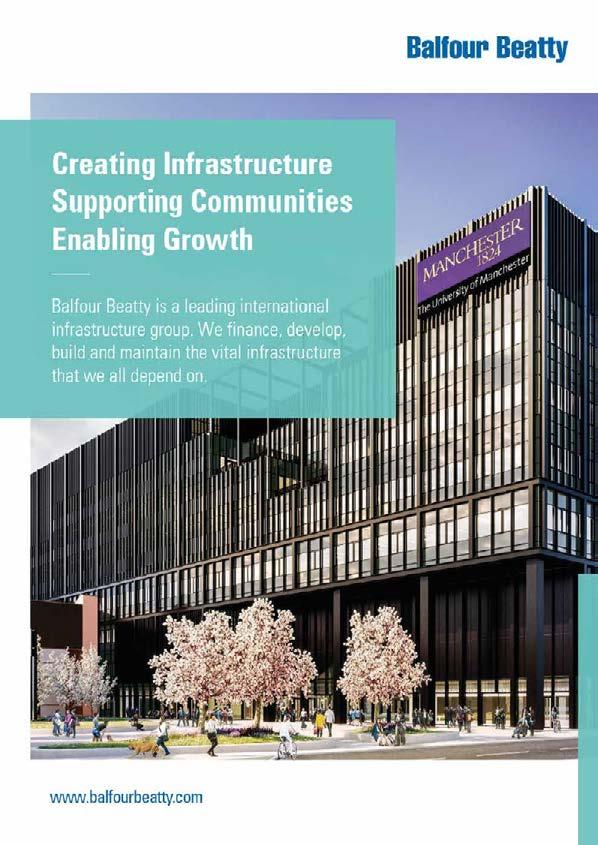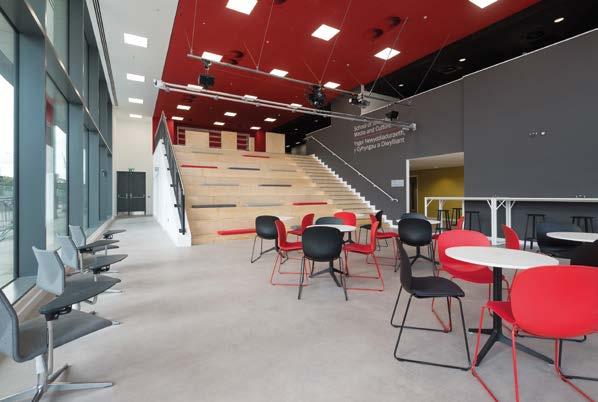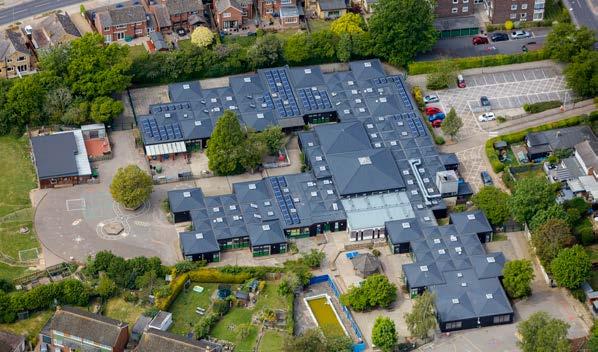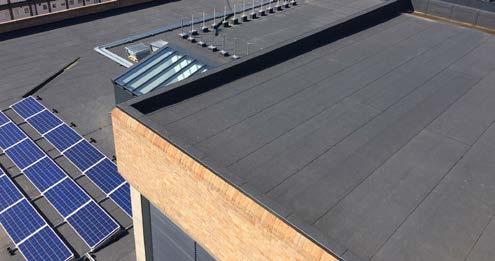
22 minute read
Futureproofing
Futureproofing universities
How can tech help?
By Kas Mohammed, VP of Digital Energy at Schneider Electric
Universities are facing in market changes. This means increased competition, institutions an existential crisis. proactively developing a futureproof must effectively invest in improving Unprecedented infrastructure that can adapt and flex student services. technological disruption, to any and all developments. Increasingly, universities are internationalisation All universities must question looking to ramp up their digital and cuts to funding, as well as their investments with the future in offering in line with the wider changing student expectations, mind. economy. Online services, such as combine to create a perfect storm portals and mobile apps, are key for higher education establishments. Four ways to futureproof to achieving this goal. Mobile apps
Universities that fail to adapt, may universities: can offer admissions information, become extinct. orientation schedules, activities,
To meet these challenges, Experience and map progress toward academic universities need to make long term Prioritising student experience goals. decisions. Fundamentally, they is critical to securing the future Mobile apps are able to empower must design strategies that factor success of universities. With students to fully control their
university experience. Sophisticated ‘engagement’ apps allow businesses and universities to host internal and external services on one userfriendly platform. For example, this could offer new students’ way-finding functionality, and combined with their induction timetable, can prevent any flustered late entries to their new classmates. Alternatively, catering services could be aligned with lecture timetables and attendance, to strategically forecast the amount of food required and prepare those coffees and toasties ahead of time.
Alongside the academic aspect of university, a student’s social life also plays a pivotal role in their experience. Engagement apps can inform students of social events and provide travel information so they can arrive on time. This common platform can enable students to attend events and meet fellow students that they may not otherwise have.
Students are now digitally native. Consequently, as technology plays a greater role in our lives, it will also be crucial to improve the student experiences.
Security
Universities present a high-value target, as they are responsible for a vast amount of private and personal data. With cyber threats a growing issue across all sectors, universities must do all in their power to safeguard the data of students and staff.
Many universities remain at risk of cyber-security breaches and attacks, as they often use multiple, disparate and outdated systems. To combat this, they are increasingly partnering to create shared cybersecurity centres that monitor threats around the clock, while encouraging students and faculties to take extra steps to protect data.
However, constantly monitoring for threats takes up huge amounts of labour and can be extremely costly. Therefore, universities should consider emerging tech such as Artificial Intelligence (AI)powered tools to identify suspicious behaviours.
Another option is universities empowering students to wield more control over their academic credentials and data after graduation or using blockchain to create secure digital records of learning and credentials.
In addition to the threats from online hackers, universities need to protect against physical breaches. Campuses need to carefully consider the physical access controls integrated into buildings, as they play a vital role in the security
IT Infrastructure
An IT infrastructure across the scale of a university campus requires continuous investment. It needs to service thousands of staff, and potentially tens of thousands of students. They, in turn, need a 24/7 system with access to links and communication around the world.
Data management at large institutions, with a fluid user base, is especially challenging. Every university department needs to be on board with the most up-to-date systems, from communication to financial management, learning resources to student information.
Modern universities are increasingly turning to advanced analytics systems to inform and improve their decision making. These systems are particularly important as universities switch to smart campus systems. These can tell users where spare parking spaces can be found, allocate meeting rooms, detect a lightbulb failure, or organise campus dorms for new arrivals.
Building Management
Almost all universities have a limited amount of space for the demands on their infrastructure.

Many are under pressure to accommodate a growing number of students, along with competing demands for facilities and resources. Thus, creating spaces that are flexible and reconfigured easily to suit different needs is an important part of the building management
Kas Mohammed

function. They need to make constant changes in the patterns of use.
Facilities are vital to the overall student experience. According to research of 1,000 students carried out by the London School of Economics (LSE) Estates Division and the Higher Education Design Quality
Forum (HEDQF), 76% ranked campus facilities as either
‘quite’ or ‘very’ important to student life.
Putting in place the correct Building Management
Solutions is critical when it comes to optimising occupant comfort. For students creating comfortable buildings has a hugely positive impact on their experience.
Going forward, technologies such as Virtual Reality are set to unlock a new level of personalised learning experience. Students will no longer have to be in the classroom to receive the classroom experience. By combining digital content, classroom technology, and faculty training, universities can continue to offer the highest possible level of learning.
Successful futureproofing
Universities that design their offerings with the future in mind will be able to take advantage of any and all developments. Therefore, senior leaders must focus on transforming the way academics work, securing data, improving student services, and modernising IT to support future innovation on campus.
Investment in technology alone is not enough. Educational institutions must evaluate the systems that can improve service and efficiency today and tomorrow if they are to meet the challenges of an increasingly digital world.
For further information on the solutions Schneider Electric provides for campuses, visit here:
www.se.com/uk/en/work/ solutions/for-business/education


The heart of Cardiff
Situated within Cardiff’s ground breaking Central
Square development and a minutes’ walk from
Cardiff Central station, Cardiff University’s
School of Journalism, Media & Culture provides a highly professional collaborative environment
Housed off a traditional Partners, Arup and ISG plc, IBI and requirements – it was truly university campus setting, Group’s architecture and interior collaboration at its best.” Project the School actively chose design experts delivered an extensive Director, Rightacres Property to co-locate at 2 Central Category B design project fully Quote: “This project was Square adjacent to the new supporting the School’s pedagogic based on a genuinely honest,
BBC Cymru Wales facilities. In joining mission and objectives. The School communicative and productive ‘one the heart of a vibrant media environ- occupied its new premises in time for team’ approach from base build ment in the city centre, the School the start of the 2018-2019 academic upward. Everyone really understood sought to strengthen the student year. the timescales involved and whilst experience and add significant value Quote: “The School was ambitious there was a relaxed communicative to student professional development & forward-thinking in taking a ethos, everyone worked hard and and employability skills. The School’s Foster-designed commercial space productively to deliver the project decision transformed 2 Central and re-imagining how higher on time and to budget.” Operations
Square into an interactive, creative education activities could flourish Director, ISG plc and professional learning space. there. IBI Group were not faced with
With the Central Square a straightforward project, and they Design for a vibrant professional development led by commercial did well to interpret client needs learning environment developer Rightacres and supported and worked closely with the base Ranked second in the UK for the by Foster & Partners, McCann & build team to coordinate their efforts quality and impact of its research
activity, in 2020 the School celebrates its fiftieth anniversary. Established in the 1970s as a pioneer in journalism education and now with close to 800 students, the School offers a wide range of undergraduate, taught postgraduate and research degree programmes highly-rated in independent surveys.
Over recent decades the School had been located within the Bute Building on Cardiff University’s Cathays Park campus. Designed in the early twentieth century to house a technical college and used as a filming location for the BBC’s Doctor Who drama series, the Grade II-listed neoclassical revival-style Bute Building remains an important element in Cardiff University’s campus estate.
Quote: “Our former home was a very impressive older building on a leafy campus. For a School on the cutting-edge of developments in a brave new digital world, however, our new home is much more closely aligned with our priorities going forward.” Stuart Allan, Head of School, School of Journalism, Media & Culture
Space within the School’s former home was insufficient and lacked flexibility. Interaction and creative conversations were not easily facilitated nor could differing operational activities and facilities be conveniently co-located. The School worked closely with staff and students before and during the design consultation phase to ensure that expectations of contemporary learning and social spaces were fully captured and fed into the design process. Careful planning also ensured that central campus facilities including IT and library services were built into the Central Square design brief.
The School had also conducted extensive evaluation of exemplary buildings designed for other Schools of Journalism around the world. The School fully understood the high expectations held by young people and wanted the learning and professionalisation experience of students to be underpinned by the best possible environment available. The School made a strong business case for investing in the design of spaces and interiors that invited
The design brief
At the heart of the brief, our client requirements centred upon the creation of a real-world dynamic media industry learning environment focused upon developing highly professional news creation, production, curation and broadcast skills. Across three floors with a total 3900m², IBI Group designed a diverse range of formal, informal, experiential and vocational learning spaces.
A central element in IBI Group’s design response involved deploying our design technology systems. The IBI Group project team utilised Autodesk Revit to ensure that the fit-out project for 2 Central Square was fully transparent, consistent and aligned with all stakeholder design, construction and maintenance requirements. Development of a fully coordinated Revit model between all design disciplines supported user engagement, where the team were able to generate fully loaded 3 dimensional drawings of all areas. And working alongside the clients’ furniture provider, IBI Group were able to model specific furniture which better supported user group understanding of the space and the flexibility in use.
This also had a crucial contribution to the effective project management including clash detection and effective cost & risk management. BIM and asset management methodologies are integrated within IBI Group’s certified quality management system and are managed as an integral component of project delivery.
IBI Group’s approach incorporated technically-advanced design features to not only enable students to excel in their chosen subject, but to further raise the profile of the School as a world-leading centre of journalism. A 300-seat lecture theatre with a glazed façade speaks directly to the principles of transparency, inclusion and collaboration, whilst a parttraditional library and seminar room area integrates contemporary design for group working and collaboration space.
IBI Group’s Head of Learning+ and School of Journalism Project Director Richard Golledge notes the importance of opening the design of teaching space to create a breakout area for students to filter into from surrounding rooms. “The central hub is an interactive and collaborative multi-functional space, with visual connectivity and proximity to surrounding newsrooms, TV and radio studios. It also provides the ‘wow’ factor for visitors and prospective students”. Within the hub, a variety of social learning spaces enable working environments for specific needs or tasks. The hub also features soft seating, flexible furniture and media displays for events, presentations, and demonstrations of degree portfolio work.
Media editing suites equipped with state-of-the-art technology facilities, postgraduate research space and ‘innovation lab’ environments were included within the brief. A double-height mezzanine within the large ground floor area

includes a ‘social stair’ providing flexible space for media production, public debates and outreach workshops. Additional study space for quiet individual learning is housed beneath the mezzanine area. Complementing these teaching and learning spaces, contiguous space was designed to foster social and public engagement.
IBI Group’s design approach focused on creating modern social spaces fully acknowledging that collaborative social learning is increasingly surpassing more traditional self-directed modes of study. 2 Central Square also contains learning spaces intentionally designed to be compact in nature, adding to the sense of real-world newsroom environments. IBI Group also encouraged a strong visual connection to the external environment providing access to the surrounding development as well as daylight. Where that was not possible, strategic use of colour was introduced to help natural wayfinding and identity, but also to stimulate the mind and create a vibrant interior.
Quote: “We’ve never before felt so socially engaged with each other. Not only can we present ourselves to stakeholders in a fundamentally different way, we’ve deliberately mixed disciplines and people in our new space to prompt creative

conversations that were previously not easily realised.” Stuart Allan, Head of School, School of Journalism, Media & Culture
Adding value to the student experience and to world-class teaching and research
The School of Journalism, Media & Culture has undergone a profound shift. 2 Central Square looks like contemporary commercial real estate, but fully enables the delivery of world-leading higher education, research and industry engagement co-located with leading Welsh media and creative sector organisations. Whilst the School and BBC Cymru Wales enjoy a strong working relationship thanks to a long-standing programme of professional training & journalism internships, the new School building acts as a shared resource, enabling a continued exchange of knowledge and experience.
But benefits for the School don’t lie just in co-location, in new build, and in proximity to major public transport networks. It’s new home in 2 Central Square delivers modern learning environments required by the subject area including smart integrated technology-led facilities, open line-of-sight collaborative areas, and flexible multi-purpose spaces for journalism and media production.
Quote: “Two Central Square is transparent, literally and conceptually. Not only does the exterior glass façade create a great first impression, the design and layout of interior space enables us to maintain it. Students and visitors can see what we do and how we do it. Our new building is open, inclusive and there’s a real buzz. We see more diversity in our engagement with industry and in our interactions with each other. There is no difficulty at all in persuading prospective students that our School delivers a world-class experience.” Stuart Allan, Head of School, School of Journalism, Media & Culture
Quote: “Two Central Square is a fantastic facility that is conducive to outstanding teaching and learning. It has a range of facilities including newsrooms, broadcasting suites and recording booths - at times you forget you are at University and not at the BBC! Unrivalled location next to the BBC and Media Wales fosters a sense of professionalism and will enable close ties to these organisations.” MA Political Communication student
For further information visit
www.ibigroup.com/ibi-projects/ cardiff-university-school-ofjournalism-media-and-culturalstudies

Condition, cost-certainty and compliance
Flat roofs on school, college terms asset management is the area. and university buildings are process of introducing, operating, A number of roofing system often out of sight, but that maintaining and then upgrading an specialists will offer this service, doesn’t mean they should be asset. This allows those responsible but it is important to look at what out of mind. Here, Tom Kerr, for the building to manage costs methods they will use and the
Sales Director at Langley Waterproof- and repairs more effectively. Asset evidence that will be gathered. The ing Systems Limited provides advice management of flat roof estates of more detailed the analysis is, the on how educational estates can schools, colleges and universities more accurate and effective the ensure the effective management can be grouped into three drivers; long-term plans will be. of their flat roofs. Focusing on how condition, cost certainty and A comprehensive roof condition understanding the estate’s condition compliance. survey will detail the roofing systems will help ensure cost-efficiency and that have been used, their current compliance, and what to look out for Condition condition, the repairs already made in an asset management partner. It is essential to understand the and any immediate concerns. Core
To minimise the risk of costly condition of the flat roof estate to samples, moisture readings and and potentially disruptive issues manage the asset more efficiently. photography will be used to assess occurring, a roof should be viewed as This can be achieved by undertaking the likelihood of any potential water an asset and managed in the same a roof condition survey to evaluate ingress. For complex or ongoing way as other systems and equipment and gain data on the current issues, a non-intrusive method such on the building. In its most basic condition and lifespan of each roof as a thermographic (infrared) survey
can be adopted.
From this information, the roofing systems specialist will be able to develop a refurbishment specification, if works are necessary, and also a long-term asset management plan. This helps those responsible for the educational estate to proactively manage the flat roof asset as well as their budgets. Refurbishment works can be addressed in order of priority and scheduled for a time that is most convenient for the organisation. Educational facilities have an advantage over those in other sectors in that breaks during the academic year, such as at Easter and during the summer, are ideal opportunities to carry out work with no disruption.
One of the key benefits of a roof asset management plan is that it will help ensure that defects are identified and rectified before they begin to undermine the structure of the roof and affect other areas in the fabric of the building. Often, relatively minor defects can be quickly found and fixed before they develop into more serious issues. This might be as simple as blocked rainwater outlets or gutters that can cause water to back up into the system causing internal leaks.
It is important for these long-term asset management plans to be combined with a schedule of planned inspections and maintenance. The predicted lifespans of the roofs are calculated on the current condition and an estimated rate of degradation based on previous experience as well as independent assessment of the lifespan of the material. It cannot take into account any accidental damage to the roof or a lack of maintenance that will shorten the expected lifespan. However, these issues can be identified during planned inspections and addressed.
Cost certainty
A typical modern flat roofing system build-up consists of a layer of insulation with membranes above and below. If the waterproofing (upper) layer fails, large volumes of water can leak into the roof structure and become trapped in the internal layers, saturating the insulation and compromising its thermal performance. Once trapped in this area, the water will freeze and thaw, expanding and contracting, placing increased pressure on the components, dramatically decreasing their lifespan and inevitably leading to leaks. When this happens, it must be addressed immediately. At this point finding the root cause of the water ingress and patching the area is unlikely to permanently fix the issue as the water trapped in the system may continue to leak into the building. In addition, any trapped moisture will turn to vapour and has the potential to cause blistering of the roof, again reducing its lifespan. If the insulation becomes saturated its performance will be severely limited, increasing operating costs in heating the building.
In addition to their limited effectiveness and the disruption caused, reactive fixes can also prove expensive. This is because the cumulative cost of repeated visits by a roofing contractor to address the problem can quickly accrue. Also, by the time the issue has been identified it may have caused further extensive damage, not only to the flat roof system but also to interior areas of the building.
High quality asset management plans will provide those managing the estate with a costed, long-term maintenance programme that could cover up to 25 years. This provides a clear view of what is needed and when, allowing it to be aligned with projected budgets and factored into financial plans. By minimising the risk of sudden or unexpected costs, financial resources can be allocated more effectively. Furthermore, identifying potential issues quickly and preventing them from escalating over time reduces the overall expenditure and in effect, reduces the lifetime cost of managing the roofs. Where appropriate, a comprehensive roof condition report can also be used to support funding applications suitable at the time.
Compliance
The roof condition survey and annual inspections will also check for

compliance with Health and Safety and Building Regulations. All roofs must be accessed in order to carry out routine maintenance or service of rooftop equipment and as such, those responsible for the building have a duty of care to ensure safe access for people working on the roof. This includes monitoring and maintaining the condition of walkways, guardrails and access systems as well as identifying potential hazards such as fragile roof areas.
Part L (Thermal Efficiency) compliance will also be looked at during the survey by core sampling and calculating the thermal efficiency of the roof. For areas that do not meet the recommended standard, a plan can be made to upgrade the roof insulation. With the Carbon Trust estimating that 22% of heat loss is through the roof, there are significant savings to be made by making the building more energy efficient.
Furthermore, a roof condition survey should also include a full assessment of fire safety compliance for each area of the roof as set out in Approved Document B of the Building Regulations. It is recommended that all flat roof systems meet Broof(t4), the highest fire classification under the European standard system.
A roof survey undertaken by experts can identify any areas of non-compliance, high risk areas, such as emergency exits (both on the roof and below) and highly flammable insulation, such as expanded polystyrene. This will not only start burning easily should a fire occur but will also generate smoke and will melt, dripping burning droplets that themselves will spread the fire.
If it is determined that works are needed through data gained from the roof condition survey, it is essential that the specification outlines any areas that are a fire risk if a flame applied roofing system is used. This can include areas around clerestory windows, pitched roof abutments or openings. It is critical for these areas that a ‘flame free’ system is installed, including safe methods for drying the roof prior to the application of any waterproofing. Following guidelines developed by the NFRC (National Federation of Roofing Contractors) known as Safe2Torch, it will allow all works to be undertaken safely and without undue risk to the occupants and the building.
Some system suppliers offer an Approved Contractor network that are vetted and then monitored throughout every project. This ensures the specification is followed and systems installed to a high standard.

Choosing the right roofing partner
Finally, when selecting a roof asset management partner, it is essential to look carefully at the level of detail and assessment they plan to carry out as part of the initial survey. As the long-term plans will be based on this, it is important to get the most accurate picture possible. The experience of the specialist is also important as the recommendations will be based on knowledge and data gained from previous similar scenarios.
The quality of on-going maintenance inspections and remedial works should also be considered. For example, at Langley we do not out-source any of the work and our team will conduct the initial survey and all annual inspections. Our ‘end-to-end’ approach to any replacement or refurbishment work means we can offer guarantees of up to 30 years. We carry out all the design work, with the installation completed by an Approved Contractor. The contractor’s operatives are fully trained and carry a card to show they have undergone the training to install the system correctly. We provide a single source of responsibility as our guarantees cover design, materials and workmanship as well as thirdparty consequential damage.
Repeated reactive fixes as issues arise quickly become expensive, putting pressure on financial resources. Managing a roof as an asset using a robust, long-term plan based on detailed analysis will help reduce costs and minimise disruption by proactively addressing any issues before they become critical. A partnership with the right roofing specialist gives those responsible for managing the estate access to expert advice and ultimately provides peace of mind.
For more on the services Langley provides for educational estates view the ‘Proactive Flat Roof Asset Management Guide’, download
www.langley.co.uk/technicaldownloads
The Diplomat™ LMS

Dynamic Self Service Laptop Loan & Charging Locker
More and more libraries are offering the opportunity to borrow a laptop or similar device for short periods of time. Offering this type of service is a great way to enhance the users experience and present a value-added extra to your library service.
Manually loaning out the devices is time consuming and often restricts when the device are available. So how can this service be automated?
The LapSafe® Diplomat™ LMS self-service device loan lockers makes device loans easy to manage. It allows users to borrow devices at any time of the day or night offering 24 x 7 x 365 access whether staff are present or not.
The Diplomat™ LMS integrates with most library management systems including the popular Capita LMS. It always deploys the best-charged device and loans laptops or similar devices just like a library book.
Deploys best charged device
Only issues the device with the most charge. Various ID options
Biometric, MiFare™, magstripe and barcode.
SmartLine™ with PowaSave™
LapSafe®’s unique integrated charging. 19” touch screen interface
Easy to use and fully customisable.
Manchester Metropolitan University, Oxford Brookes University and Dublin City University are just a few customers using the Diplomat LMS lapsafe.com/news/case-studies



